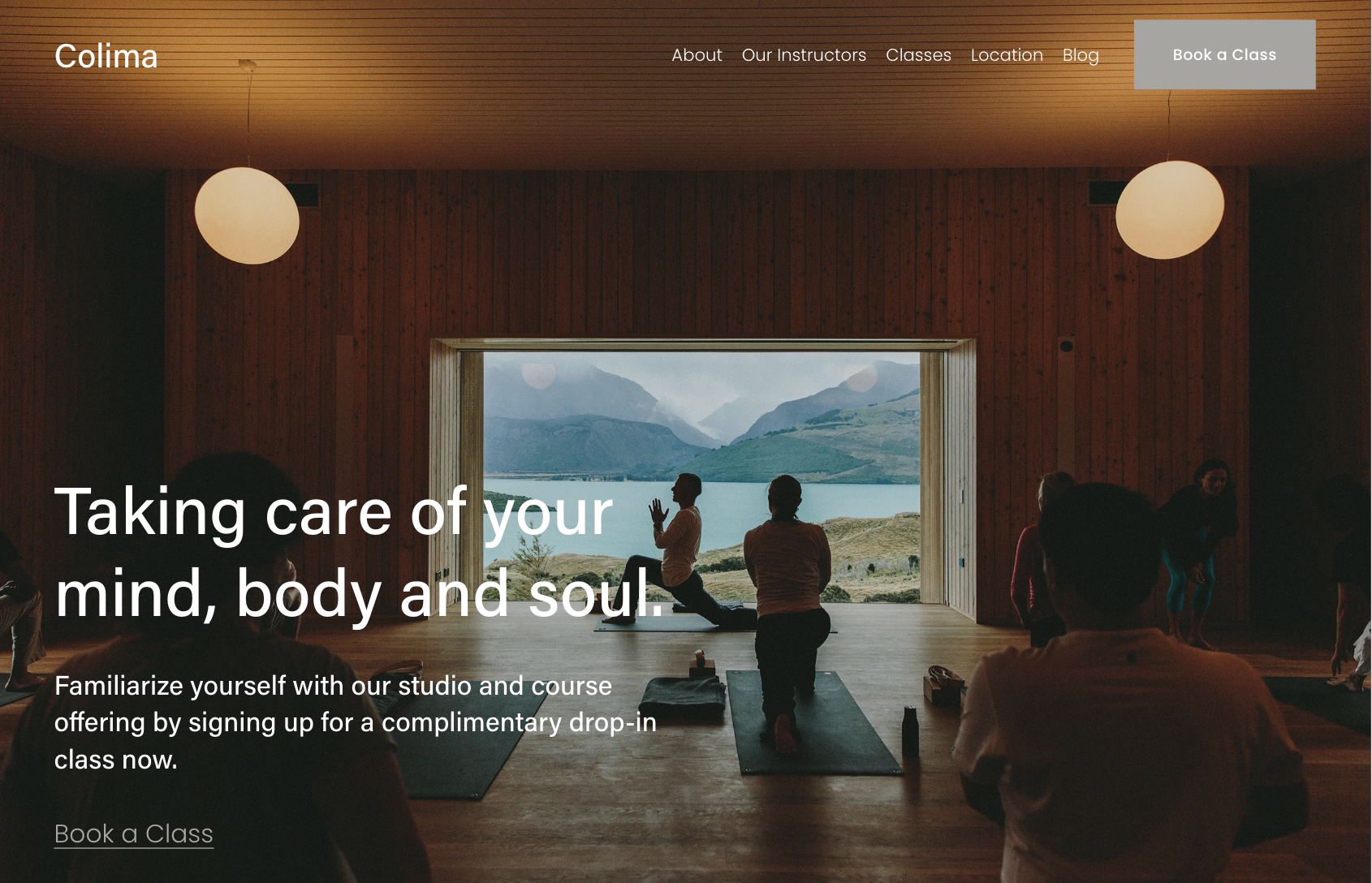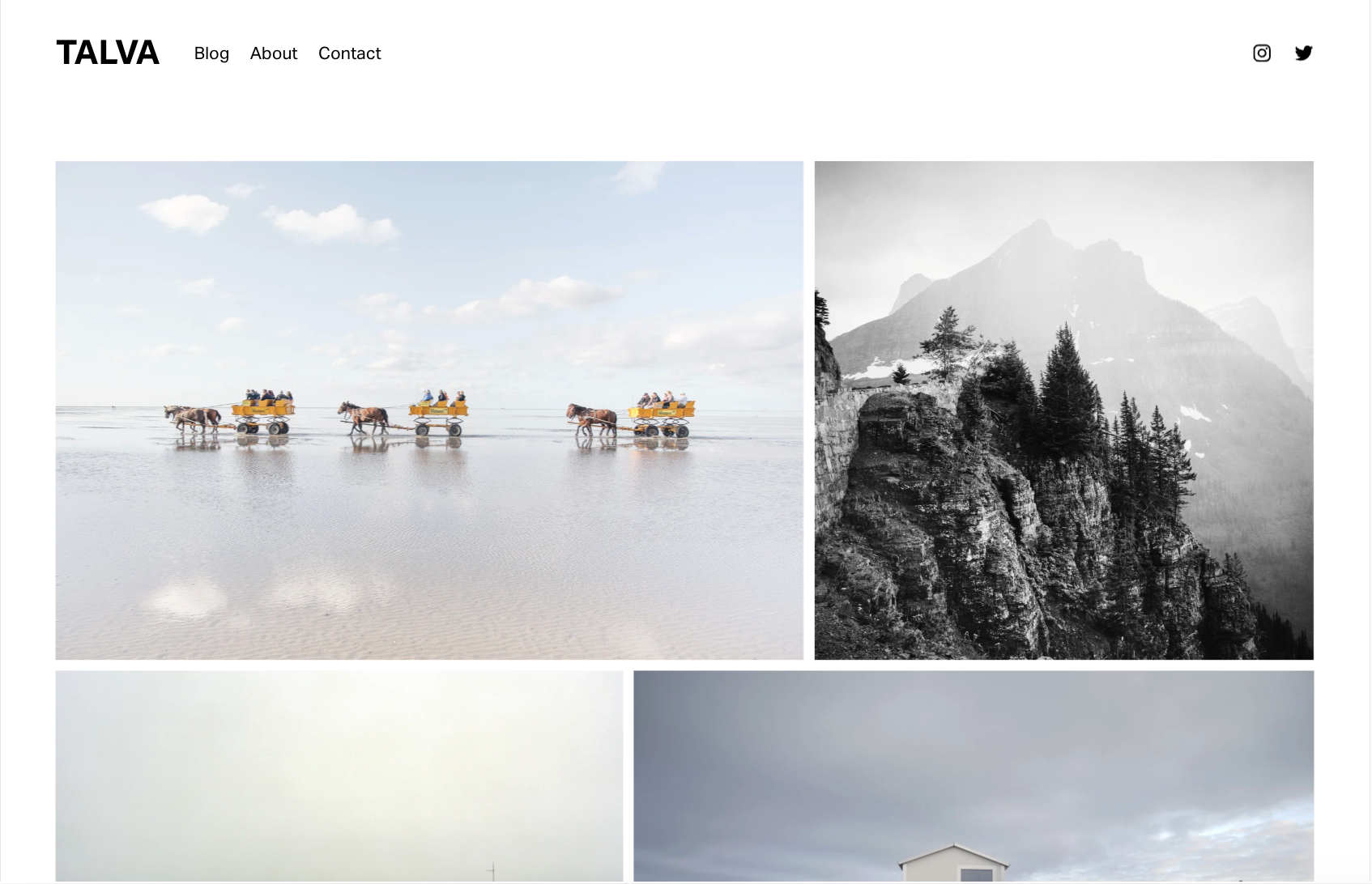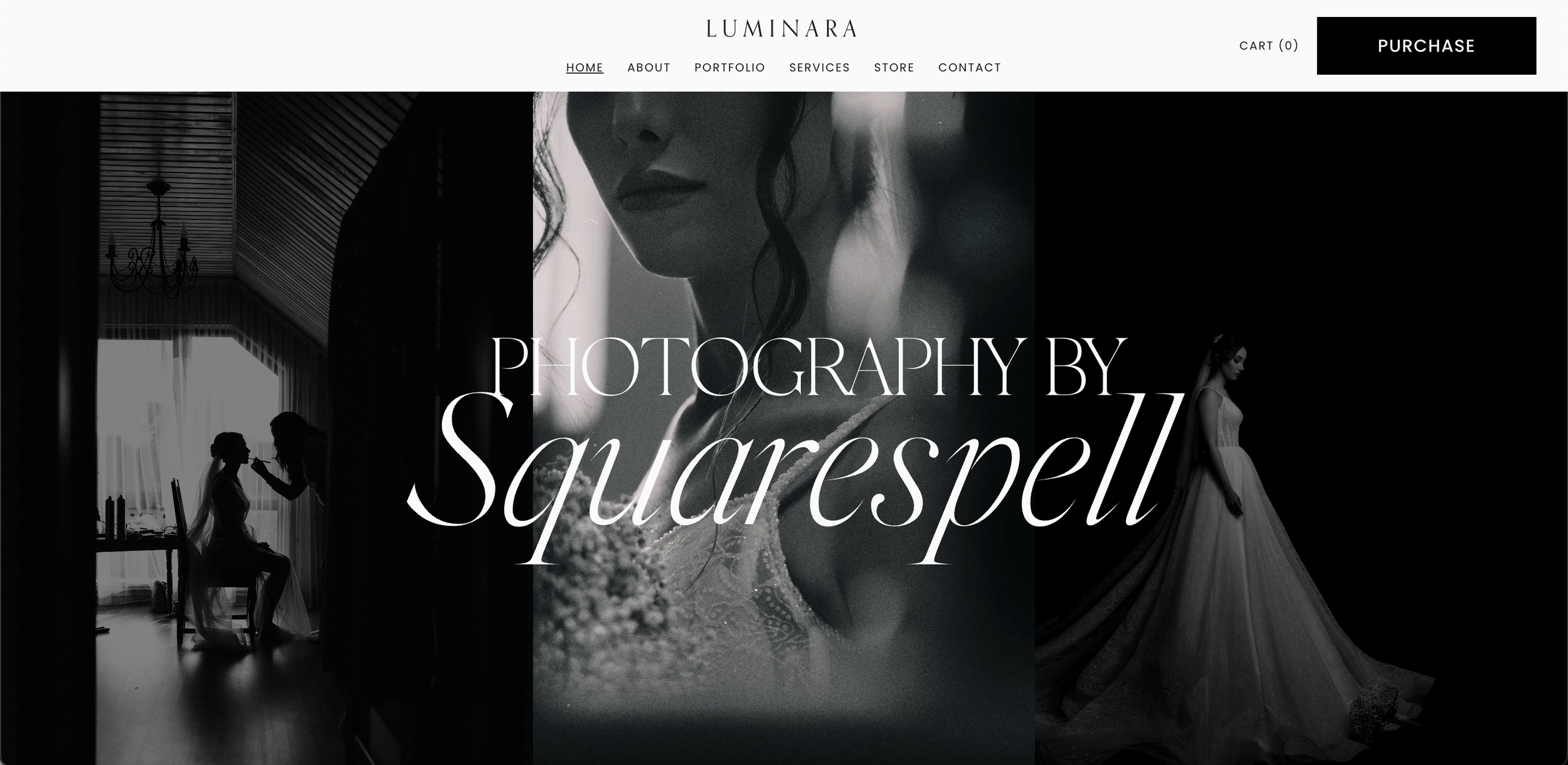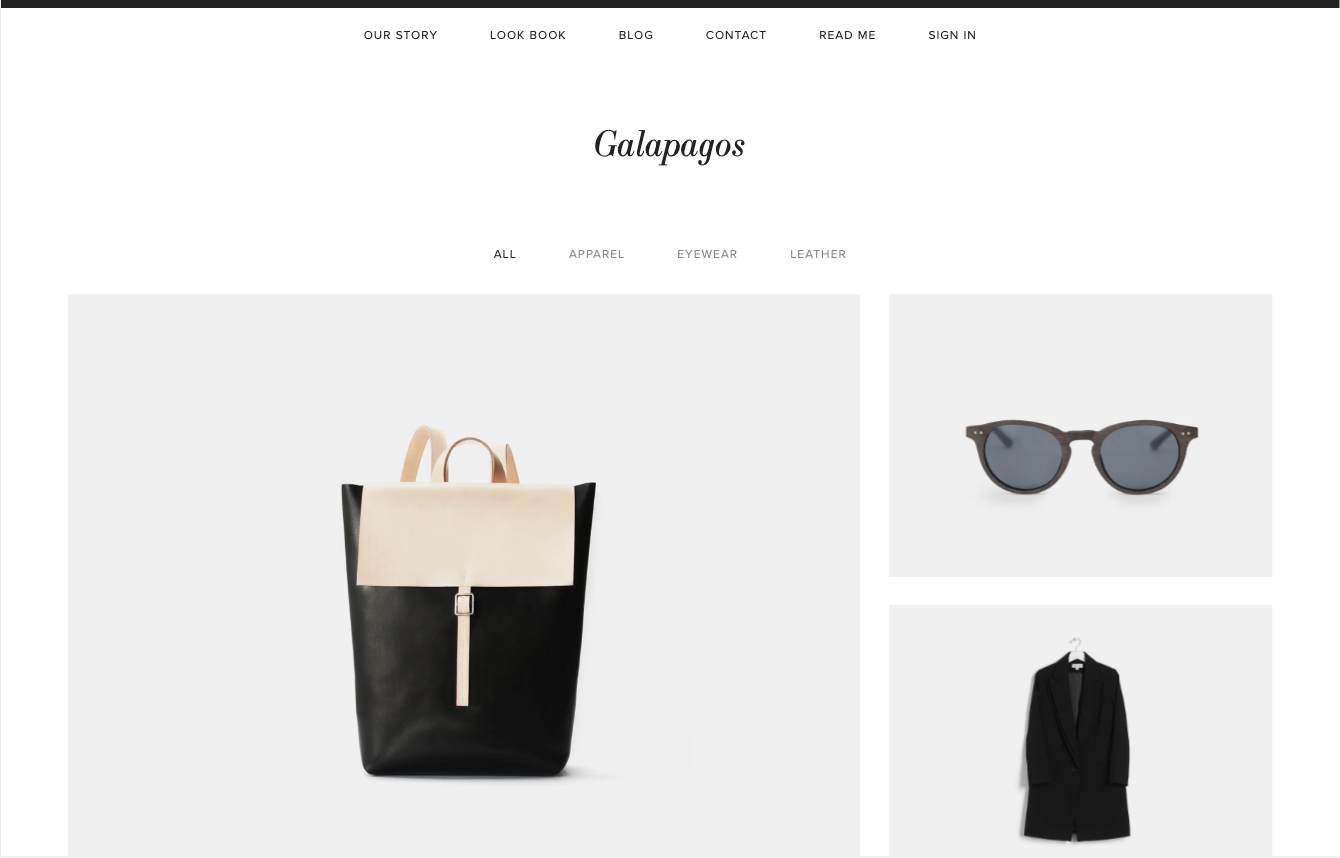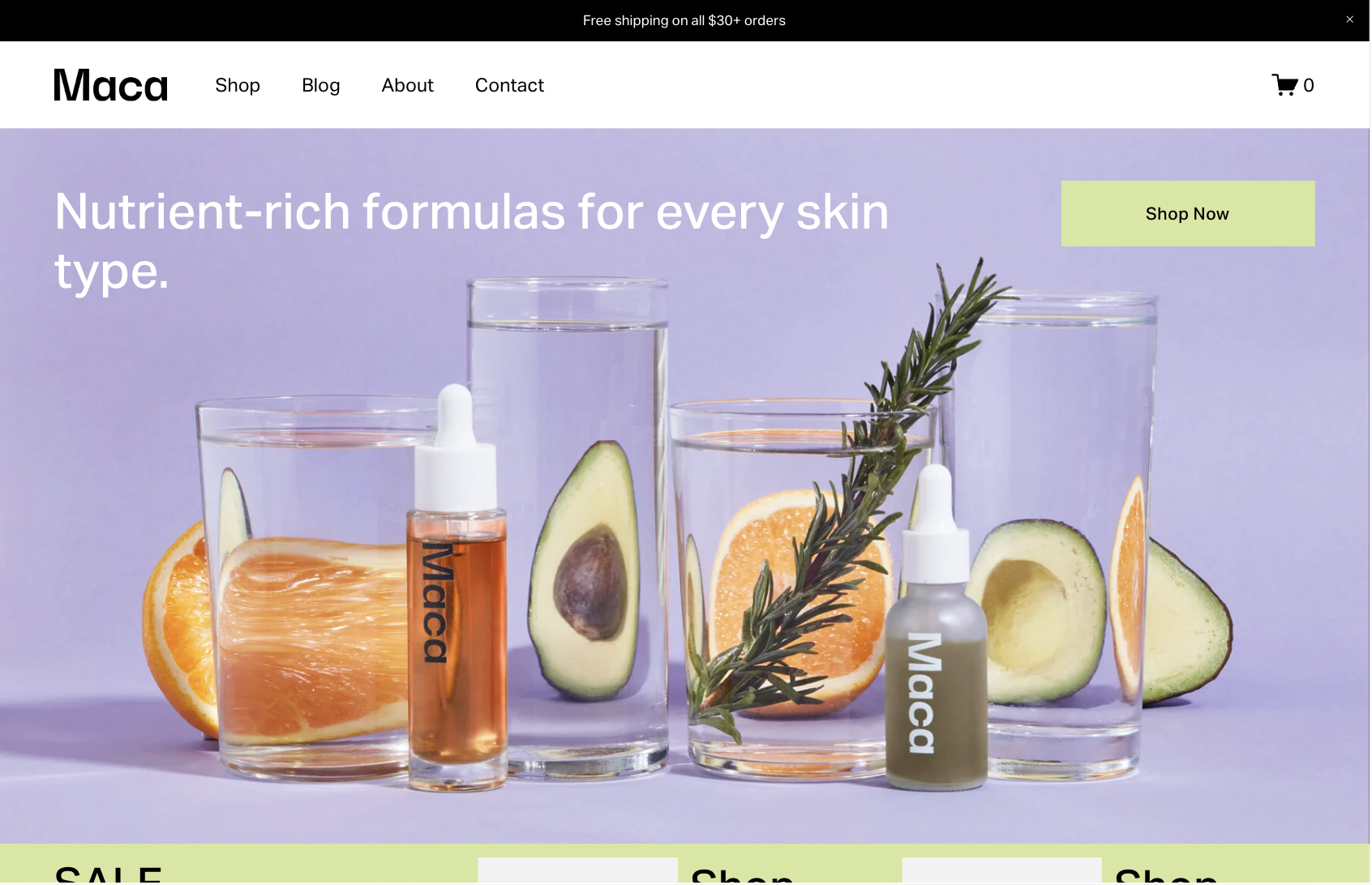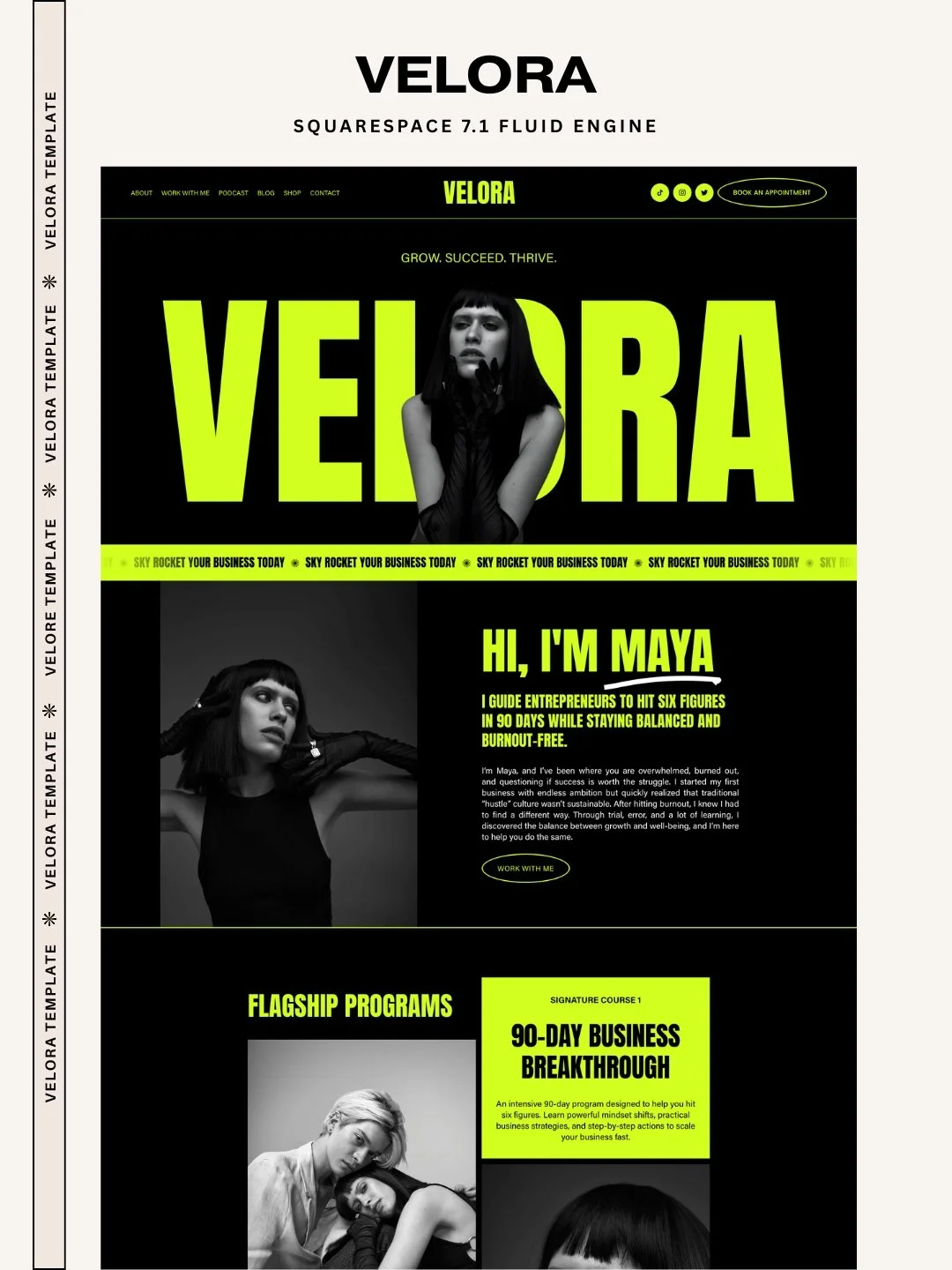The Complete Guide to Pairing Squarespace Templates with Essential Plugins for 2025: Match Your Design with Functionality
You've spent hours browsing Squarespace templates, and you've finally found the one it's sleek, modern, and perfectly captures your brand aesthetic. You hit "Get Started," customize the colors and fonts, upload your images, and then... you realize something's missing.
You need booking functionality for your coaching sessions. Or maybe you want a mega menu for your extensive product catalog. Perhaps you're looking for animated scroll effects to bring your portfolio to life. Suddenly, you're faced with a crucial question that most Squarespace users ask too late: "Will my beautiful template support the functionality I actually need?"
This is the Template-Plugin Paradox and it's costing creative entrepreneurs, coaches, and small business owners countless hours of frustration, not to mention potential revenue from features they can't implement.
Here's the truth that most template marketplaces won't tell you: choosing the right template is only half the equation. The other half? Knowing which plugins will work seamlessly with your chosen design to create a complete, functional website that actually serves your business goals.
In this comprehensive guide, we're bridging that gap. You'll discover how to strategically pair Squarespace templates with essential plugins, ensuring your website looks stunning and performs flawlessly. Whether you're a beginner overwhelmed by options or a seasoned pro looking to streamline your workflow, this framework will transform how you approach Squarespace website building.
Why Template Selection Affects Plugin Performance (And Vice Versa)
Before we dive into specific pairings, let's understand why this relationship matters.
The Technical Reality
Squarespace templates aren't just visual shells they're architectural frameworks that determine how content is structured, displayed, and interacted with. When you add a plugin (custom code that enhances functionality), it needs to integrate with your template's existing structure.
Here's what can go wrong:
Layout conflicts: A sidebar plugin might break on a template without proper content area divisions
Mobile responsiveness issues: Animation plugins can cause jerky scrolling on templates with heavy visual elements
Performance degradation: Gallery-focused templates combined with multiple media plugins can significantly slow load times
Code injection limitations: Some template structures make it difficult to target specific sections with custom code
Visual inconsistencies: A mega menu plugin might clash with a template's minimalist header design
The Strategic Opportunity
But when done right, the template-plugin combination becomes powerful:
Amplified strengths: A clean template becomes conversion-focused with strategic popup and form plugins
Compensated weaknesses: A visually simple template gains wow-factor through animation and interactive plugins
Future-proof flexibility: The right foundation makes it easy to add features as your business evolves
Competitive differentiation: Unique template-plugin combinations set you apart from cookie-cutter competitors
Understanding Squarespace 7.1: The Foundation for Modern Pairing
Before we explore specific combinations, you need to understand the platform you're working with.
Squarespace 7.1 vs 7.0: Why It Matters
If you started your Squarespace website after January 2020, you're likely on version 7.1. This is crucial because plugin compatibility differs significantly between versions.
Squarespace 7.1 advantages for plugin integration:
All templates share the same core features (no more "template families")
Fluid Engine provides unprecedented design flexibility
Better mobile responsiveness for plugin additions
More consistent code structure for easier plugin integration
Template switching without rebuilding (though full content migration isn't automatic)
How to check your version: Log into Squarespace → Help menu. You'll see either "Squarespace 7.0" with your template family, or "Squarespace 7.1" listed.
Important: If you're on 7.0, most modern plugins won't work. Consider using Squarespace's free Update Tool to migrate to 7.1 before investing in premium plugins.
Template Categories and Their Natural Plugin Affinities
Squarespace organizes templates into categories, and each category naturally pairs better with certain plugin types:
Portfolio & Creative Templates (Talva, Wexley, Matsuya)
Best for: Photographers, designers, artists
Natural plugins: Lightbox enhancements, before/after sliders, gallery filters
Challenge: Heavy visuals can slow performance choose lightweight animation plugins
Blog & Content Templates (Grove, Native, Vester)
Best for: Writers, journalists, content creators
Natural plugins: Sidebar plugins, related posts, table of contents, reading time estimators
Challenge: Minimalist designs may need visual enhancement through typography and subtle animation plugins
Service-Based Templates (Bailard, Bedford, Colima)
Best for: Coaches, consultants, service providers
Natural plugins: Booking integrations, testimonial sliders, FAQ accordions, contact form enhancements
Challenge: Need to balance professionalism with personality choose refined, not flashy plugins
E-commerce Templates (Galapagos, Maca, Seen)
Best for: Online stores, physical product businesses
Natural plugins: Product filters, wishlist functionality, variant swatches, review displays
Challenge: Too many plugins can slow checkout flow prioritize conversion-critical features
Restaurant & Hospitality Templates (Juniper, Vance)
Best for: Restaurants, cafes, venues
Natural plugins: Menu displays, reservation systems, Google Maps enhancements, review integrations
Challenge: Mobile experience is critical test all plugins thoroughly on actual devices
The 4-Question Framework for Strategic Template Plugin Matching
Before choosing any template or plugin, answer these four questions:
Question 1: What is my primary business goal for this website?
If your answer is "Generate leads":
Template priority: Clean, conversion-focused layouts with prominent CTAs
Plugin priority: Popup forms, exit-intent triggers, lead magnets, email integration
Recommended combination: Bailard template + Promotional Popup 2.0 + embedded Calendly
If your answer is "Sell products/services":
Template priority: Product-focused with strong imagery and clear information hierarchy
Plugin priority: Enhanced checkout experience, reviews, wishlist, product filters
Recommended combination: Galapagos template + Universal Filter Plugin + Testimonial Slider
If your answer is "Showcase portfolio/work":
Template priority: Image-forward with flexible gallery layouts
Plugin priority: Lightbox enhancements, project filters, case study presentations
Recommended combination: Talva template + Lightbox Anything + Animate on Scroll
If your answer is "Build authority/community":
Template priority: Blog-optimized with good readability and content organization
Plugin priority: Related posts, table of contents, social proof, newsletter integration
Recommended combination: Grove template + Sidebar Plugin + Social Feed integrations
Question 2: How complex is my content structure?
Simple structure (5-10 pages):
You can work with almost any template
Focus plugins on visual enhancement and micro-interactions
Avoid: Complex navigation plugins you don't need
Moderate structure (10-30 pages):
Choose templates with good native navigation options
Consider: Simple mega menu or accordion navigation plugins
Prioritize: Search functionality and content filtering
Complex structure (30+ pages):
Absolutely need: Mega menu plugin for navigation
Critical: Universal filter or search enhancement plugins
Consider: Custom breadcrumb navigation plugins
Question 3: What is my technical comfort level?
Beginner (no coding experience):
Choose: Templates with built-in features closest to your needs
Plugin approach: Stick to visual customization tools (Spark Plugin, SquareKicker)
Avoid: Plugins requiring custom CSS or complex code injection
Intermediate (comfortable with copy-paste code):
Flexibility: Most standard plugins will work for you
Sweet spot: Plugins with good documentation and support
Opportunity: Can combine 2-3 complementary plugins effectively
Advanced (comfortable with custom coding):
Freedom: Can modify plugin code to fit template perfectly
Advantage: Can create custom plugin combinations for unique effects
Responsibility: Maintain documentation for future updates
Question 4: What are my performance priorities?
Speed is critical (e-commerce, competitive niches):
Template choice: Lighter designs with fewer default animations
Plugin strategy: Maximum 3-5 essential plugins only
Must-test: Load time after each plugin installation
Visual impact is priority (creative portfolios, luxury brands):
Template choice: Visually rich starting points
Plugin strategy: High-quality animation and interaction plugins
Balance: Use lazy loading and optimization plugins to maintain acceptable speed
Mobile experience is paramount (B2C businesses, local services):
Template choice: Mobile-first responsive designs
Plugin strategy: Test everything on actual mobile devices before deployment
Critical: Ensure plugins don't interfere with mobile navigation
Strategic Template Plugin Pairings by Business Type
Now let's get specific. Here are battle-tested combinations for different business types:
For Coaches & Course Creators
The Challenge
Coaches need to establish authority, showcase testimonials, offer booking functionality, and potentially sell digital products all while maintaining a professional, trustworthy appearance.
Recommended Template: Vera, Bailard or Colima
Why: Both feature clean, professional layouts with strong header imagery and clear content hierarchy. Bailard has a classic structure perfect for established coaches, while Colima offers a more modern, wellness-focused aesthetic.
Essential Plugin Stack:
1. Acuity Scheduling or Calendly Integration
Purpose: Seamless booking for discovery calls and coaching sessions
Pro tip: Use Calendly Redirector plugin ($19) to create custom thank-you pages after booking
Result: Professional booking experience without leaving your site
2. Testimonial Slider Plugin by SQSP Themes ($39)
Purpose: Showcase client success stories dynamically
Implementation: Create a dedicated testimonials blog collection
Result: Social proof without cluttering your homepage
3. Promotional Popup 2.0 by SQMods
Purpose: Targeted lead generation with exit-intent
Strategy: Different popups for different pages (e.g., free guide on blog, discovery call on services page)
Result: 3-5% increase in email captures
4. Accordion Tabs Plugin
Purpose: Organize service packages or FAQ content
Best use: Service comparison page or extensive FAQ section
Result: Cleaner pages, improved user experience
5. Video Background or VideoAsk
Purpose: Personal connection through video
Best use: Homepage hero section or chat widget with personal video greeting
Result: Dramatically increased engagement and trust
Budget Friendly Alternative Stack (Under $200):
Free Acuity Scheduling (comes with Squarespace Business plan)
Create testimonial section using native Squarespace quote blocks + custom CSS
Use native Squarespace promotional popup with manual page targeting
Spark Plugin ($11/month) for overall design enhancements including accordions
Setup Priority:
Get template installed and basic branding complete
Set up Acuity/Calendly (this is your conversion goal)
Add testimonials (build trust)
Implement popup (capture leads)
Add enhancement plugins (polish experience)
For Visual Portfolios (Photographers, Designers, Artists)
The Challenge
Need stunning visual presentation that lets work speak for itself, while maintaining fast load times and providing easy navigation through multiple projects.
Recommended Template: Talva, Matsuya, or Luminara
Why: These templates prioritize full-width imagery with gallery adaptive layouts. Talva offers the most flexibility, Matsuya has the cleanest minimal aesthetic, and Wexley provides the best balance of imagery and context.
Essential Plugin Stack:
1. Lightbox Anything Plugin by Squarespell
Purpose: Create popups for project details, team bios, or additional images without navigation
Pro use: Popup entire case studies from portfolio thumbnails
Result: Keep visitors engaged on single page while providing deep content
2. Universal Filter Plugin ($70)
Purpose: Allow visitors to filter portfolio by category, medium, year, client type
Critical for: Portfolios with 15+ projects
Result: Improved user experience, longer session times
Purpose: Add subtle reveal animations to images and text
Key: Keep it subtle let your work be the star
Result: Modern, polished feel without overwhelming content
Purpose: Showcase transformations (photo retouching, room designs, web redesigns)
Best use: For projects where the transformation is the selling point
Result: Compelling visual storytelling
5. Custom Table Block or Gallery Captions Enhancement
Purpose: Add project details (client, year, medium) in organized format
Implementation: Create consistent metadata display across all projects
Result: Professional presentation of project information
Mobile Optimization Checklist:
Test gallery swiping on actual phones
Ensure filter plugin has mobile-friendly interface
Verify lightbox popups don't break mobile scrolling
Check image load times on 4G connection
Confirm navigation remains accessible after plugin installation
Performance Protection Strategy:
Because visual portfolios load many high-res images, plugin choice is critical:
Do: Use lazy loading for gallery images
Do: Compress images before upload (aim for under 500KB per image)
Don't: Add more than 2-3 animation plugins
Don't: Use auto-play video backgrounds (huge performance hit)
Test: Use Google PageSpeed Insights after each plugin installation
For Service Providers (Consultants, Agencies, Professional Services)
The Challenge
Balance professional credibility with approachability, showcase complex services clearly, and provide multiple conversion paths (consultation booking, quote requests, email signup).
Recommended Template: Serene or Paloma
Why: These templates offer traditional professional structures with strong text hierarchy, making them ideal for explaining complex services while maintaining visual interest.
Essential Plugin Stack:
1. Mega Menu Plugin by Squarespell ($25)
Purpose: Organize extensive service offerings in clear dropdown
Critical when: You have multiple service categories or industry specializations
Result: Improved navigation, reduced bounce rate
2. Dynamic Animated Counter Plugin (Free)
Purpose: Display impressive statistics (years in business, clients served, success rate)
Best placement: About page or homepage statistics section
Result: Credibility boost through quantified achievements
3. Advanced Contact Form with Conditional Logic
Purpose: Qualify leads and gather specific information based on their needs
Implementation: Different form fields appear based on service type selected
Result: Higher quality leads, better initial client information
4. Related Posts Plugin ($39)
Purpose: Keep visitors engaged with relevant case studies and insights
Best use: Blog and case study pages to increase pageviews
Result: 2-3x increase in pages per session
5. Sidebar Plugin by SQSP Themes ($59)
Purpose: Add consistent CTAs, contact info, or resource downloads to blog
Strategic use: Different sidebars for different content categories
Result: Improved lead generation from content marketing efforts
Additional Power Move:
Case Study Lightbox System: Use Lightbox Anything plugin to create popup case studies from your homepage. Visitors can browse multiple case studies without navigating away, keeping them engaged and making it easier to consume multiple examples of your work.
For E-commerce Stores
The Challenge
Maximize product discoverability, build trust through reviews, streamline the buying process, and differentiate from marketplace competitors.
Recommended Template: Galapagos, Maca, or Seen
Why: Purpose-built for product display with multiple layout options, hover effects, and quick-view capabilities.
Essential Plugin Stack:
1. Universal Filter Plugin ($70)
Purpose: Advanced product filtering by price, category, color, size, etc.
ROI: 15-30% increase in product discovery
Critical for: Stores with 20+ products
2. Product Variant Swatches
Purpose: Display color and size options as visual swatches instead of dropdown
User experience: Much faster product browsing
Conversion impact: Reduced cart abandonment
3. Review Display Integration (Yotpo, Loox, or Elfsight Reviews)
Purpose: Showcase customer reviews and ratings
Trust factor: Essential for new stores competing with Amazon
Best placement: Product pages and homepage
4. Wishlist/Favorites Plugin by SF.Digital
Purpose: Allow customers to save products for later
Benefit: Capture interest even when visitors aren't ready to buy
Remarketing: Email campaign opportunities for saved items
5. Abandoned Cart Recovery (MotionMail or Privy)
Purpose: Automatically email customers who didn't complete purchase
ROI: Can recover 10-15% of abandoned carts
Essential: For stores with average order value over $50
Mobile Commerce Essentials:
Critical: Ensure product filters work smoothly on mobile
Required: Test entire checkout flow on actual smartphones
Recommended: Use sticky "Add to Cart" button plugin for mobile
Don't miss: Verify swatch plugins display properly on small screens
Conversion Rate Optimization Stack:
Start with Universal Filter (product discovery)
Add variant swatches (reduce friction)
Implement reviews (build trust)
Set up wishlist (capture intent)
Enable abandoned cart recovery (recapture lost sales)
Install in this order and measure conversion rate impact after each addition.
For Content Creators & Bloggers
The Challenge
Maximize content discoverability, keep readers engaged across multiple articles, grow email list, and monetize through affiliates or digital products.
Recommended Template: Grove or Vester
Why: These templates prioritize readability and content organization, with Grove being the most minimalist, Native offering the most flexibility, and Vester providing excellent filtering for essay writers.
Essential Plugin Stack:
1. Sidebar Plugin by SQSP Themes ($59)
Purpose: Add consistent navigation, popular posts, email signup, and CTAs
Game-changer: Squarespace 7.1 doesn't have native blog sidebar
Result: 40-60% increase in email signups from blog traffic
2. Table of Contents Plugin
Purpose: Generate clickable outline for long-form articles
SEO benefit: Increased time on page, lower bounce rate
Reader benefit: Easy navigation to specific sections
3. Related Posts Plugin ($39)
Purpose: Automatically display relevant articles at bottom of each post
Traffic impact: 2-3x pages per session
Implementation: Uses tags and categories for smart recommendations
4. Social Share Enhancement Plugin
Purpose: Beautiful, functional social sharing buttons
Placement: Top and bottom of articles, sticky sidebar
Result: 3-5x increase in social shares
5. Reading Progress Bar or Estimated Reading Time
Purpose: Show readers how much content remains
Psychology: Reduces abandonment of longer articles
Implementation: Include in blog post template
Email List Growth Stack:
Promotional Popup 2.0 with exit-intent (primary capture)
Sidebar opt-in form with lead magnet (secondary capture)
In-content opt-in using code blocks (contextual capture)
Thank you page popup after reading 3+ articles (engaged reader capture)
Monetization-Ready Additions:
For Affiliate Marketing:
Link attribution plugin (automatically add rel="sponsored" to affiliate links)
Product showcase boxes using custom CSS in code blocks
Comparison tables using Custom Table Block
For Digital Products:
MemberSpace integration for members-only content
Digital Downloads (native Squarespace feature on Commerce plan)
Testimonial sliders for product social proof
Technical Considerations: Making Plugins & Templates Play Nice
Performance: The Hidden Cost of Plugin Overload
Every plugin adds code to your site. Too many plugins = slow site = lost visitors and lower search rankings.
Performance Protection Rules:
Rule 1: The Rule of 5 Limit yourself to 5 active custom code plugins maximum. Each additional plugin exponentially increases potential conflicts.
Rule 2: Measure Before and After Use Google PageSpeed Insights before and after each plugin installation. If score drops below 70, reconsider.
Rule 3: Mobile-First Testing Test on actual 4G mobile connections. WiFi testing doesn't reveal real-world performance issues.
Rule 4: Async Loading When Possible For plugins that don't need to load immediately (like chat widgets), use async or defer attributes in code injection.
High-Performance Plugin Combinations:
Squarespell + Calendly + Native Squarespace popup = Minimal impact
Sidebar Plugin + Related Posts + Social Share = Manageable impact
Universal Filter + Review Display = Noticeable but acceptable impact
Performance-Killing Combinations to Avoid:
Multiple animation libraries (stick to one)
Multiple gallery enhancement plugins
Heavy plugins + video backgrounds + auto-play media
Plugins that load external fonts + custom fonts in CSS
Code Injection Strategy: Getting Plugins in the Right Place
Most Squarespace plugins use Code Injection. Understanding where to inject code prevents conflicts.
Code Injection Locations:
Header (Settings → Advanced → Code Injection → Header):
Use for: Critical functionality that must load first
Examples: Analytics, fonts, global plugins affecting entire site
Warning: Can slow initial page load if overused
Footer (Settings → Advanced → Code Injection → Footer):
Use for: Non-critical functionality
Examples: Chat widgets, social feeds, enhancement plugins
Benefit: Doesn't block page rendering
Page-Specific (Page Settings → Advanced → Page Header/Footer):
Use for: Plugins only needed on specific pages
Examples: Booking form on services page, product filter on shop page
Benefit: Reduces unnecessary code on other pages
Code Blocks (Add to specific sections):
Use for: Plugins that affect only one section
Examples: Individual forms, embed widgets, specific animations
Benefit: Most targeted injection method
Best Practice Workflow:
Read plugin documentation for recommended injection location
Test on a duplicate page first
Clear cache and test in incognito window
Check mobile display
Verify no conflicts with existing plugins
Document what you installed and where (future you will thank you)
Squarespace 7.1 vs 7.0: The Compatibility Divide
Critical Information: Plugin compatibility is fundamentally different between versions.
Squarespace 7.0 Plugins:
Often template-family specific (Brine family, Bedford family, etc.)
May target specific CSS classes that don't exist in 7.1
Typically include template name in compatibility list
Squarespace 7.1 Plugins:
Built for universal template compatibility
Use more generic targeting methods
Generally work across all 7.1 templates with minimal adjustment
Red Flags When Buying Plugins:
✗ No version compatibility listed
✗ Last updated before 2021 (likely 7.0 only)
✗ Documentation references template families
✗ Demo site is clearly 7.0 design
Green Flags:
✓ Explicitly states "Squarespace 7.1 compatible"
✓ Recent updates (within last 6 months)
✓ Documentation mentions Fluid Engine
✓ Responsive design guaranteed
Mobile Responsiveness: The Non-Negotiable
Over 60% of website traffic comes from mobile devices. If your plugins break mobile experience, you're losing over half your potential audience.
Mobile Testing Checklist for Every Plugin:
Navigation Plugins:
Menu still accessible and usable on phone screens
Dropdowns don't get cut off by screen edges
Touch targets are at least 44x44 pixels
No hover-only functionality (use tap instead)
Form Plugins:
Form fields are large enough to tap easily
Keyboard doesn't obscure submit button
Validation messages are visible above keyboard
Auto-fill works properly
Animation Plugins:
Animations are smooth, not janky
No horizontal scrolling created
Touch gestures work (swipe, pinch, etc.)
Battery drain is acceptable (avoid infinite animations)
Gallery/Image Plugins:
Images scale properly to screen size
Lightboxes work with touch gestures
Filters have mobile-friendly interface
Load time is acceptable on 4G
Real Device Testing Requirements: Test on at least:
One iPhone (iOS Safari)
One Android phone (Chrome)
One tablet (any platform)
Don't rely on browser developer tools they don't accurately represent touch interactions or performance.
Troubleshooting Common Plugin Template Conflicts
Problem: Plugin displays incorrectly or not at all
Solution Steps:
Clear Squarespace cache (Settings → Advanced → Clear Cache)
Check code injection location matches documentation
Verify you're on correct Squarespace version (7.0 vs 7.1)
Temporarily disable other plugins to identify conflicts
Check browser console for JavaScript errors (F12 → Console tab)
Contact plugin developer with specific template name and error details
Problem: Plugin works on desktop but breaks on mobile
Solution Steps:
Check if plugin has mobile-specific CSS you need to add
Look for conflicting media queries in Custom CSS
Verify plugin is designed to be responsive
Test in actual Safari (iOS) and Chrome (Android), not just desktop simulation
Consider alternative plugin with better mobile support
Problem: Site loads slowly after plugin installation
Solution Steps:
Use PageSpeed Insights to identify specific slowdowns
Move non-critical plugins from Header to Footer code injection
Check if plugin loads external resources (fonts, scripts, images)
Consider replacing plugin with lighter alternative
Implement lazy loading for media-heavy plugins
Problem: Plugins conflict with each other
Solution Steps:
Identify which two plugins are conflicting (disable one at a time)
Check if both plugins target same elements or functions
Try adjusting load order (Header vs Footer injection)
Look for "no conflict" modes in plugin settings
Contact plugin developers sometimes they can provide compatibility fixes
2025 Design Trends: Templates & Plugins to Achieve Them
Let's implement the hottest design trends with strategic template plugin combinations.
Trend 1: Organic Matter (Nature Inspired Aesthetics)
What it is: Earth tones, organic shapes, textured backgrounds, and natural imagery creating warm, grounded experiences.
Template Foundation: Choose templates with neutral color palettes and flexible image placement. Colima, Grove, or Loam work beautifully.
Plugin Implementation:
Gradient backgrounds plugin (Free): Add subtle earth-tone gradients
Custom shapes in sections: Use Spark Plugin to add organic curved dividers
Texture overlays: Add subtle noise or paper textures via Custom CSS
Soft animations: Gentle fade-ins and parallax effects (Animate on Scroll)
Execution Example:
Choose Colima template (already has warm, organic aesthetic)
Customize colors to earth tones (terracotta, sage, sand, charcoal)
Add Spark Plugin's curved section dividers between major page sections
Implement subtle parallax scrolling on hero images
Use organic imagery throughout (plants, natural textures, landscape photos)
Result: Website feels warm, inviting, and grounded—perfect for wellness, sustainability, or lifestyle brands.
Trend 2: Vivid Glow (Bold, High Energy Aesthetics)
What it is: Vibrant gradients, neon accents, glowing effects, and high-contrast color combinations creating energetic, modern experiences.
Template Foundation: Start with templates that have dark backgrounds or strong contrast capabilities. Nolan, Arcade, or custom dark mode versions of any template.
Plugin Implementation:
Gradient background effects (Free): Animated color gradients
Glow effects CSS: Add neon glows to buttons and CTAs
Bold animation plugins: Dynamic reveals, hover effects
Custom button styling: Spark Plugin for glowing, animated buttons
Execution Example:
Choose template with dark background support
Customize with bold color palette (electric blue, hot pink, lime green, purple)
Add animated gradient backgrounds to hero sections
Style buttons with glow effects using Custom CSS
Implement bold hover animations on images and elements
Result: High-energy, attention-grabbing website perfect for entertainment, tech, or youth-focused brands.
Trend 3: Visual Smiles (Playful, Joy Focused Design)
What it is: Whimsical illustrations, playful typography, unexpected micro-interactions, and delightful surprise elements.
Template Foundation: Squarespace templates with flexible typography and clean layouts. Waverly, Paloma, or Clune provide good starting points.
Plugin Implementation:
Animated icons and illustrations: Custom code or Spark Plugin
Playful cursor effects: Custom JavaScript for cursor interactions
Micro-interaction animations: Hover effects, click feedback
Fun loading animations: Custom loading screens with personality
Execution Example:
Choose template with strong typography support
Use custom fonts with personality (round, friendly sans-serifs)
Add illustrated elements or custom icons throughout
Implement playful hover states on buttons and images
Create surprise interactions (Easter eggs, animated elements)
Result: Delightful, memorable website that makes visitors smile—ideal for creative services, children's brands, or fun lifestyle products.
Trend 4: Just My Type (Typography First Design)
What it is: Bold, oversized typography as the primary design element, with dramatic type hierarchy and creative text treatments.
Template Foundation: Templates with strong text hierarchy capabilities. Bedford, Vester, or Native work well as starting points.
Plugin Implementation:
Custom font loader: Google Fonts or Adobe Fonts integration
Animated text effects: Fade-in, slide-in, type-out animations
Reading experience enhancements: Table of contents, reading time
Typography-focused layouts: Custom CSS for creative text arrangements
Execution Example:
Choose template with excellent text readability
Implement dramatic font pairings (bold display + elegant serif)
Use oversized headings (72px+ on desktop)
Add subtle text animations on scroll
Create visual hierarchy through type alone, minimal graphics
Result: Sophisticated, editorial-feeling website perfect for publishers, thought leaders, or text-heavy professional services.
Trend 5: Sketchbook Aesthetic (Hand Drawn, Authentic Feel)
What it is: Sketchy illustrations, hand-drawn elements, imperfect shapes, and artisanal qualities creating authentic, human-centered experiences.
Template Foundation: Clean templates that allow illustrations to shine. Talva, Matsuya, or customized versions of minimal templates.
Plugin Implementation:
Custom illustrations: Add via image blocks or background images
Hand-drawn dividers: SVG elements between sections
Sketch-style animations: Custom CSS for draw-on effects
Textured backgrounds: Subtle paper or canvas textures
Execution Example:
Choose minimal template (lets custom illustrations stand out)
Commission or create hand-drawn illustrations for key sections
Add sketch style section dividers
Implement draw on animation for illustrations (appears to draw itself)
Use hand drawn icons throughout navigation and content
Result: Authentic, artisanal feeling website perfect for handmade goods, creative services, or brands emphasizing craftsmanship.
Building Your Perfect Template Plugin Stack: A Decision Framework
By now you understand the principles. Let's create your personal action plan.
Step 1: Define Your Website's Core Purpose
Complete this sentence: "The primary goal of my website is to _________________."
Your answer determines your foundation:
Generate leads → Service template + booking/form plugins
Sell products → Commerce template + shopping enhancement plugins
Build authority → Blog template + content discovery plugins
Showcase work → Portfolio template + gallery enhancement plugins
Build community → Content template + engagement plugins
Step 2: Audit Your Must-Have Features
Create a list divided into three categories:
Non-Negotiable (Must Have Day 1): These are features you absolutely cannot launch without.
Examples:
Booking system for coaching calls
Product filtering for 50+ item store
Mobile-responsive portfolio gallery
Email signup capability
Important (Add Within First Month): Features that significantly improve experience but aren't launch-blockers.
Examples:
Testimonial slider
Related posts functionality
Advanced contact forms
Review display system
Nice to Have (Future Additions): Features that would be great but aren't critical to core business function.
Examples:
Chat widget
Advanced animations
Custom calculators
Interactive elements
Why this matters: Starting with too many plugins creates complexity, performance issues, and decision fatigue. Build your foundation first, then enhance strategically.
Step 3: Calculate Your Budget Reality
Template Investment: $40-$300 (premium Squarespace templates) Plugin Budget Categories:
Starter Budget ($0-$150/year):
Use primarily free plugins and native Squarespace features
Consider one essential paid plugin (e.g., Universal Filter or Sidebar Plugin)
Focus on DIY customization using Custom CSS
Best for: New businesses, solopreneurs testing ideas
Growth Budget ($150-$500/year):
Invest in 3-5 premium plugins that directly support revenue
Mix of one-time purchases and subscriptions
Custom code where needed for unique functionality
Best for: Established businesses with proven business model
Professional Budget ($500-$1,500/year):
Full suite of premium plugins
Custom development for unique features
Advanced integrations and automations
Best for: Agencies, high-volume businesses, premium brands
Budget Allocation Strategy:
60% on conversion-critical plugins (booking, filtering, checkout enhancements)
25% on trust-building plugins (testimonials, reviews, social proof)
15% on enhancement plugins (animations, visual improvements)
Step 4: Map Your Customer Journey
Understanding how visitors move through your site determines which plugins matter most.
Awareness Stage (First Visit):
User needs: Quick understanding of what you offer
Plugin priorities: Fast loading, clear navigation, visual appeal
Key plugins: Performance optimization, subtle animations, mega menu (if complex)
Consideration Stage (Exploring Options):
User needs: Detailed information, social proof, comparison capability
Plugin priorities: Testimonials, case studies, portfolio filters, FAQ accordions
Key plugins: Testimonial sliders, lightbox popups, related content, filtering
Decision Stage (Ready to Buy/Book):
User needs: Easy action, trust signals, minimal friction
Plugin priorities: Smooth booking/checkout, reviews, guarantees
Key plugins: Booking integrations, payment enhancements, cart recovery
Loyalty Stage (Repeat Visitors):
User needs: New content, community connection, exclusive value
Plugin priorities: Blog enhancements, member areas, email integration
Key plugins: Sidebar, related posts, member login, content gating
Journey Mapping Exercise:
Draw out your typical customer path (homepage → about → services → booking)
Identify friction points where visitors drop off
Select plugins that specifically address those friction points
Prioritize plugins that improve conversion at critical decision moments
Step 5: Template-Plugin Compatibility Check
Before committing to any combination, verify compatibility:
Pre-Purchase Checklist:
For Templates:
✓ Confirm it's Squarespace 7.1 (unless you specifically need 7.0)
✓ Check demo site for mobile responsiveness
✓ Verify it has the layouts you need (gallery styles, blog layouts, etc.)
✓ Read reviews for any reported plugin compatibility issues
✓ Confirm template is actively maintained (updated within last 6 months)
For Plugins:
✓ Verify Squarespace version compatibility (7.0 vs 7.1)
✓ Check if demo is available to test
✓ Read documentation for setup complexity
✓ Verify mobile responsiveness is guaranteed
✓ Check refund/support policy
✓ Look for compatibility notes with popular templates
✓ Search for user reviews and real-world implementations
Compatibility Testing Process:
Set up template on test site or duplicate page
Install first plugin, test thoroughly
Add second plugin, test for conflicts
Continue one at a time, testing after each addition
Do final comprehensive test of all features together
Test on multiple devices and browsers
Red Flag Combinations to Avoid:
Multiple mega menu plugins (choose one)
Multiple animation libraries (AOS, GSAP, custom—pick one)
Multiple form enhancement plugins (creates conflicts)
Plugins from same category by different developers (usually conflict)
Expert Implementation Strategies
The Phased Rollout Approach
Don't install everything at once. Use this proven phased approach:
Phase 1: Foundation (Week 1)
Install template
Set up basic branding (colors, fonts, logo)
Create core page structure
Install ONE conversion-critical plugin only
Test thoroughly across devices
Phase 2: Conversion Optimization (Week 2)
Add booking/contact functionality
Implement primary lead capture
Set up essential forms
Add ONE trust-building plugin (testimonials or reviews)
Phase 3: Enhancement (Week 3)
Add navigation improvements if needed
Implement content discovery features
Add subtle animations or visual enhancements
Maximum ONE new plugin
Phase 4: Polish (Week 4)
Final design tweaks
Performance optimization
Comprehensive testing
Analytics setup to measure plugin effectiveness
Benefits of Phased Approach:
Easier to identify source of any issues
Better understanding of each plugin's impact
Prevents overwhelm and decision fatigue
Allows for performance testing at each stage
Reduces risk of conflicts
The Plugin Performance Dashboard
Track plugin effectiveness with these metrics:
For Each Plugin, Monitor:
Performance Impact:
PageSpeed score before and after
Load time increase (aim for under 0.5 seconds per plugin)
Mobile performance score
Largest Contentful Paint (LCP) change
User Impact:
Bounce rate change on pages with plugin
Time on page difference
Click-through rate on plugin features (filters, lightboxes, etc.)
Conversion rate impact
Technical Health:
Console errors (check browser console)
Mobile responsiveness issues
Cross-browser compatibility
Conflict with other plugins
Create Simple Tracking Spreadsheet:
| Plugin Name | Cost | Performance Impact | User Engagement | Conversion Impact | Keep/Remove Decision |
|---|---|---|---|---|---|
| Sidebar Plugin | $20 | -5 PageSpeed | +45% time on blog | +2.3% email signups | KEEP |
| Animation Library | Free | -12 PageSpeed | -8% bounce rate | No impact | REMOVE |
Decision Criteria:
Keep: Positive user engagement OR conversion impact with acceptable performance hit
Optimize: Good results but performance concerns—look for lighter alternatives
Remove: No measurable benefit or significant performance degradation
Advanced Plugin Combination Strategies
The Power Stack (3-Plugin Maximum): Choose three plugins that work synergistically:
Example Stack 1: Lead Generation Machine
Sidebar Plugin (persistent signup opportunities)
Exit-Intent Popup (capture abandoning visitors)
Related Posts (increase pageviews, more conversion opportunities)
Example Stack 2: E-commerce Conversion Optimizer
Universal Filter (product discovery)
Review Display (trust building)
Wishlist Plugin (capture intent for remarketing)
Example Stack 3: Portfolio Authority Builder
Lightbox Anything (portfolio deep-dives)
Testimonial Slider (social proof)
Before/After Slider (transformation showcase)
Why Three?
Enough to significantly enhance functionality
Few enough to maintain performance
Manageable complexity for troubleshooting
Clear ROI measurement possible
The Template Switching Strategy
One advantage of Squarespace 7.1: you can switch templates without starting over (though with limitations).
When to Consider Template Switch:
Current template doesn't support needed plugins well
Mobile experience is poor
Business focus has shifted significantly
Performance issues tied to template structure
Before Switching Templates:
What Transfers Automatically:
All page content (text, images)
Blog posts and products
Custom CSS (though may need adjustment)
Code injections (may need repositioning)
What Requires Reconfiguration:
Section layouts (may break)
Custom spacing and positioning
Some plugin placements
Mobile layout customizations
Template Switch Process:
Backup everything: Export content, screenshot all pages
Test on duplicate site first: Never switch on live site without testing
Check plugin compatibility with new template: Verify all plugins work
Redesign section layouts: Expect to rebuild some sections
Comprehensive testing: Every page, every plugin, every device
Plan for downtime: Even with preparation, expect 1-2 hours of non-optimal appearance
Alternative to Switching: Sometimes customizing your current template with CSS is faster than switching. Consider hiring a Squarespace developer for heavy customization before abandoning your current template.
Real World Case Studies: Successful Template Plugin Combinations
Case Study 1: Wellness Coach
Business: Life coach specializing in stress management and work-life balance Monthly Traffic: 2,000 visitors Primary Goal: Book discovery calls
Template: Colima (warm, wellness-focused aesthetic)
Plugin Stack:
Acuity Scheduling integration (booking)
Testimonial Slider by SQSP Themes (social proof)
Promotional Popup 2.0 (lead magnet delivery)
Spark Plugin (design enhancements and accordions for FAQ)
Implementation Strategy:
Homepage features video introduction with embedded Calendly below
Services page uses accordion plugin for detailed service descriptions
Testimonial slider on homepage and About page
Exit-intent popup offers free stress assessment PDF
Blog uses Spark Plugin for enhanced styling and readability
Results:
Discovery call bookings increased 67% in first month
Email list growth increased 3x through popup implementation
Mobile booking rate improved from 23% to 41%
Average session duration increased from 1:20 to 2:45
Key Success Factor: Focused on one conversion goal (booking calls) and ensured every plugin supported that goal or built trust toward it.
Case Study 2: Boutique Photographer
Business: Wedding and portrait photographer Monthly Traffic: 5,000 visitors Primary Goal: Portfolio bookings
Template: Luminara
Plugin Stack:
Lightbox Anything (portfolio case studies)
Universal Filter ($70) (filter by wedding style, season, location)
Contact form enhancement (detailed inquiry form)
Implementation Strategy:
Portfolio page with filter by wedding style, season, and location
Each portfolio thumbnail opens lightbox with full wedding story
Lightbox includes 15-20 images, client testimonial, and booking CTA
Separate galleries for weddings, engagements, portraits
Blog showcases recent work with filter capability
Results:
Portfolio engagement time increased from 2:15 to 6:30 per session
Inquiry form submissions increased 45%
67% of visitors now use filter functionality
Mobile portfolio browsing improved significantly
Key Success Factor: Solved the "how do I show enough work without overwhelming visitors" problem through filtering and lightbox storytelling.
Case Study 3: Handmade Jewelry Store
Business: Artisan jewelry e-commerce Monthly Traffic: 8,000 visitors Primary Goal: Product sales
Template: Galapagos (e-commerce focused)
Plugin Stack:
Universal Filter (filter by material, price, style)
Product Variant Swatches (visual color selection)
Wishlist plugin (save favorites)
Implementation Strategy:
Shop page features prominent filtering (material, price range, occasion)
Product pages show color variants as swatches instead of dropdown
Reviews displayed prominently on product pages and homepage
Wishlist allows customers to save items for later
Email automation for abandoned wishlists
Results:
Conversion rate increased from 1.2% to 2.8%
Average order value increased 23% (better product discovery through filtering)
Cart abandonment decreased from 73% to 58%
Return customer rate increased 34%
Key Success Factor: Addressed the main e-commerce challenges (product discovery, trust, decision-making support) with targeted plugins.
Case Study 4: Design Agency
Business: Brand and web design agency Monthly Traffic: 3,500 visitors Primary Goal: Consultation bookings and project inquiries
Template: Bedford (professional, content-rich)
Plugin Stack:
Mega Menu by Squarespell (organize extensive service offerings)
Case Study Lightbox system (portfolio deep-dives)
Dynamic Animated Counter (showcase stats)
Sidebar Plugin (blog CTAs and resource downloads)
Implementation Strategy:
Mega menu organizes services by industry and service type
Portfolio grid with lightbox case studies (challenge, solution, results)
Homepage displays animated counters (projects completed, clients served, years in business)
Blog sidebar promotes free resources and consultation booking
Separate case study sections for different industries
Results:
Navigation clarity improved bounce rate by 18%
Case study engagement increased from 30% to 78% of portfolio visitors
Consultation booking rate increased 52%
Resource downloads (lead capture) increased 3x
Key Success Factor: Made complex service offerings easy to navigate while providing deep-dive content for serious prospects.
Your Free Template Plugin Pairing Cheat Sheet
Quick Reference Guide by Business Type
Coaches & Consultants:
Template: Vera or Colima
Must-have plugins: Acuity/Calendly + Testimonial Slider + Popup
Budget: $100-$200
Setup time: 2-3 days
Photographers & Visual Artists:
Template: Luminara or Matsuya
Must-have plugins: Lightbox Anything + Universal Filter
Budget: $150-$250
Setup time: 3-4 days
E-commerce Stores:
Template: Galapagos or Maca
Must-have plugins: Universal Filter + Reviews + Wishlist
Budget: $200-$400
Setup time: 4-5 days
Bloggers & Content Creators:
Template: Grove or Native
Must-have plugins: Sidebar Plugin + Related Posts + Popup
Budget: $100-$200
Setup time: 2-3 days
Service Businesses:
Template: Noura or Paloma
Must-have plugins: Mega Menu + Contact Form Enhancement + Testimonials
Budget: $150-$300
Setup time: 3-4 days
Plugin Priority Matrix
Install First (Conversion Critical):
Booking/scheduling integration
Contact form enhancements
Payment/checkout optimization
Product filtering (e-commerce)
Install Second (Trust Building):
Testimonial displays
Review systems
Social proof elements
Case study showcases
Install Third (Enhancement):
Navigation improvements
Content discovery (related posts, etc.)
Lead capture systems
Visual enhancements
Install Last (Polish):
Animations
Micro-interactions
Advanced features
Experimental elements
Budget Friendly Plugin Alternatives
Instead of Universal Filter ($70):
Use native Squarespace categories + custom CSS styling
Create separate collection pages for major categories
Limitation: Less dynamic, requires more pages
Instead of Sidebar Plugin ($59):
Use code blocks with custom HTML/CSS for sidebar-like sections
Create persistent CTAs using fixed positioning CSS
Limitation: More manual work, less flexible
Instead of Mega Menu ($25):
Optimize native Squarespace folder structure
Use strategic parent/child page organization
Limitation: Less visual organization for complex structures
Free Plugin Resources:
Squarespace Circle Community (free code snippets)
Ghost Plugins free options
Will Myers free tutorials
SQSP Themes free resources
Common Mistakes to Avoid
Mistake 1: Choosing Template for Looks Alone
The Problem: You fall in love with a template's demo but it doesn't support your business needs.
Real Example: Choosing an image-heavy portfolio template for a service business that needs extensive text and multiple service pages.
The Fix: List your functional requirements BEFORE browsing templates. Non-negotiables might include: blog layouts, service page structures, booking integration capability, product filtering, etc.
Decision Framework:
List must-have features
Filter templates by compatibility with those features
Choose the best-looking option from compatible templates
Mistake 2: Installing Too Many Plugins Day One
The Problem: Excitement leads to installing 10+ plugins immediately, causing performance issues and conflicts.
Real Example: New store owner installs filtering, reviews, wishlist, chat widget, popup, animation library, and custom forms—site speed drops 60%.
The Fix: Use the phased rollout approach. Start with ONE conversion-critical plugin. Test. Add second plugin. Test. Maximum 3-5 total plugins.
Red Flag Signs:
PageSpeed score below 70
Mobile site feels sluggish
Plugins aren't working as expected
Console shows JavaScript errors
Mistake 3: Ignoring Mobile Experience
The Problem: Testing only on desktop, missing critical mobile issues.
Real Example: Filter plugin works beautifully on desktop but creates horizontal scrolling on mobile, making site unusable for 65% of traffic.
The Fix: Test every plugin on actual mobile devices (not just browser simulation). iPhone + Android minimum. Check:
Touch targets are large enough
No horizontal scrolling
Popups don't break experience
Load time is acceptable
Mistake 4: Not Measuring Plugin ROI
The Problem: Keeping plugins that look cool but don't actually serve business goals.
Real Example: Keeping expensive animation plugin that creates "wow factor" but actually increases bounce rate because it slows load time.
The Fix: Create simple tracking system:
Set up Google Analytics events for plugin interactions
Note conversion rates before and after plugin installation
Monitor PageSpeed score impact
Remove plugins that don't positively impact key metrics
Mistake 5: Buying Plugins Without Checking Compatibility
The Problem: Purchasing plugins that don't work with your Squarespace version or template.
Real Example: Buying a Squarespace 7.0 plugin when you have a 7.1 site, or buying plugin designed for specific template family.
The Fix:
Always check version compatibility (7.0 vs 7.1)
Read full description for template requirements
Check refund policy before purchase
Look for demos or trials when available
Mistake 6: Neglecting Performance Optimization
The Problem: Adding plugins without considering cumulative performance impact.
Real Example: Site with beautiful template and great plugins but 8-second load time, losing 70% of visitors before page fully loads.
The Fix:
Run PageSpeed Insights before and after each plugin
Compress all images before upload
Use lazy loading for images and videos
Minimize number of external resources loading
Consider plugin alternatives if performance suffers
Mistake 7: Poor Code Injection Management
The Problem: Adding plugin code randomly without organization or documentation.
Real Example: Code injection section becomes jumbled mess, impossible to troubleshoot when something breaks. Can't remember which code does what.
The Fix:
Add comments in code explaining what each section does
Use consistent formatting
Document in separate file what plugins you've installed and where
Take screenshots before making changes
Use version control if you're technical
The Future: Preparing for Squarespace Evolution
Squarespace's Direction for 2025 and Beyond
Squarespace continues evolving. Stay ahead with these insights:
Fluid Engine Maturation: Squarespace's Fluid Engine (drag-and-drop interface) is becoming more powerful. Future plugin developers will likely create Fluid Engine-specific tools.
What this means for you:
Templates will become increasingly flexible
Plugin integration may become more visual, less code-heavy
Mobile responsiveness will improve natively
AI Integration: Squarespace is investing in AI-powered features for content creation and design assistance.
What this means for you:
Content creation plugins may become less necessary
AI-powered personalization could become standard
Template customization may become easier
Commerce Enhancements: E-commerce functionality continues to improve with native features.
What this means for you:
Some plugins may become obsolete as features go native
More advanced commerce features without plugins
Better integration with selling platforms
Building a Future-Proof Setup
Strategy 1: Favor Platform-Agnostic Skills Learn CSS, basic JavaScript, and design principles. These skills transfer even if Squarespace changes dramatically.
Strategy 2: Choose Actively Maintained Plugins Select plugins from developers who regularly update and improve their products. Check:
Last update date (within 3-6 months ideal)
Developer responsiveness to support questions
Compatibility updates when Squarespace releases changes
Strategy 3: Keep Plugin Dependencies Minimal The fewer plugins you rely on, the easier it is to adapt when platforms change.
Strategy 4: Document Everything Keep clear records of:
Which plugins you use and why
Custom code and its purpose
Settings and configurations
Before/after metrics
Strategy 5: Stay Educated
Follow Squarespace Circle community
Subscribe to Squarespace developer updates
Join relevant Facebook groups or forums
Follow key plugin developers
Taking Action: Your 7-Day Implementation Plan
Day 1: Research and Decision
Tasks:
Define your primary website goal
List must-have features
Review this guide's recommendations for your business type
Choose 2-3 template options
List 3-5 potential plugins
Deliverable: Clear decision document with template choice and priority plugin list
Day 2: Template Setup
Tasks:
Purchase and install chosen template
Set up basic branding (logo, colors, fonts)
Create page structure
Add placeholder content
Deliverable: Basic branded website structure ready for content and plugins
Day 3: Content Addition
Tasks:
Write and add homepage content
Create about page
Set up services/products/portfolio
Add initial blog posts if applicable
Deliverable: Complete content in place, no plugins yet
Day 4: First Plugin Installation
Tasks:
Install ONE conversion-critical plugin only
Configure according to documentation
Test thoroughly on desktop
Test on mobile devices
Deliverable: One working plugin, fully tested
Day 5: Trust-Building Plugin
Tasks:
Install testimonial/review plugin
Add content (testimonials, reviews, social proof)
Style to match template
Test interaction with first plugin
Deliverable: Two working plugins with no conflicts
Day 6: Enhancement Plugin
Tasks:
Install navigation or content discovery plugin
Configure settings
Test all plugins together
Check performance with PageSpeed Insights
Deliverable: Complete plugin stack, performance verified
Day 7: Final Testing and Launch
Tasks:
Comprehensive testing on multiple devices
Check all forms and bookings work
Verify mobile experience
Set up analytics tracking
Launch or update live site
Deliverable: Fully functional website with optimized template-plugin combination
Conclusion: Your Template Plugin Success Formula
Building a successful Squarespace website isn't about finding the "perfect" template or installing the most plugins. It's about strategic thinking:
The Template-Plugin Success Formula:
Clear Goals → Choose template that supports your primary business objective
Functional Priorities → Select 3-5 plugins that address specific user needs
Strategic Implementation → Install and test one plugin at a time
Performance Monitoring → Track impact on speed and user behavior
Continuous Optimization → Remove what doesn't work, enhance what does
Remember:
Your template is your foundation choose wisely but know you can customize heavily
Plugins are tools, not decorations each should serve a specific purpose
Performance matters more than "coolness" protect your load time
Mobile experience is non-negotiable test on real devices
Less is often more three great plugins beat ten mediocre ones
Your Next Step:
Don't let perfect be the enemy of good. Choose a template that's 80% right, add 2-3 essential plugins, and launch. You can always refine later.
The difference between successful Squarespace sites and mediocre ones isn't access to secret templates or magical plugins—it's strategic thinking about how design and functionality work together to serve real business goals.
Start Building Your Perfect Squarespace Site Today
Ready to put this knowledge into action? At Squarespell, we create premium Squarespace templates specifically designed to work seamlessly with essential plugins.
Explore our template collection: Each Squarespell template includes detailed documentation on recommended plugin pairings and implementation guides.
Join our community: Get access to exclusive tutorials, plugin recommendations, and ongoing support as Squarespace evolves.
Need personalized guidance? Book a free 15-minute consultation to discuss your specific template and plugin needs.
Remember: Your website is your digital storefront. Invest the time to get the template-plugin combination right, and you'll reap the rewards for years to come.
Additional Resources
Template-Plugin Compatibility Checker




